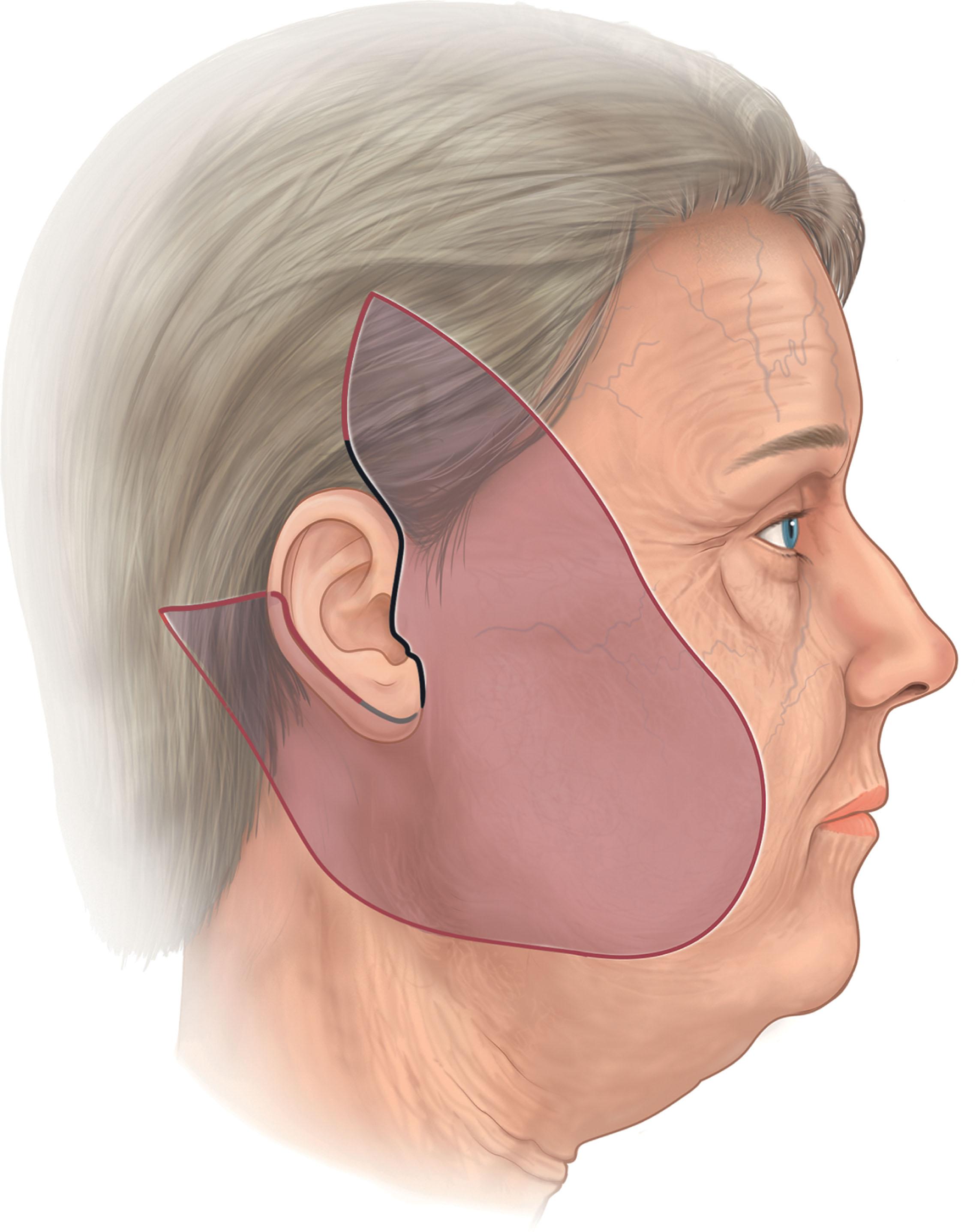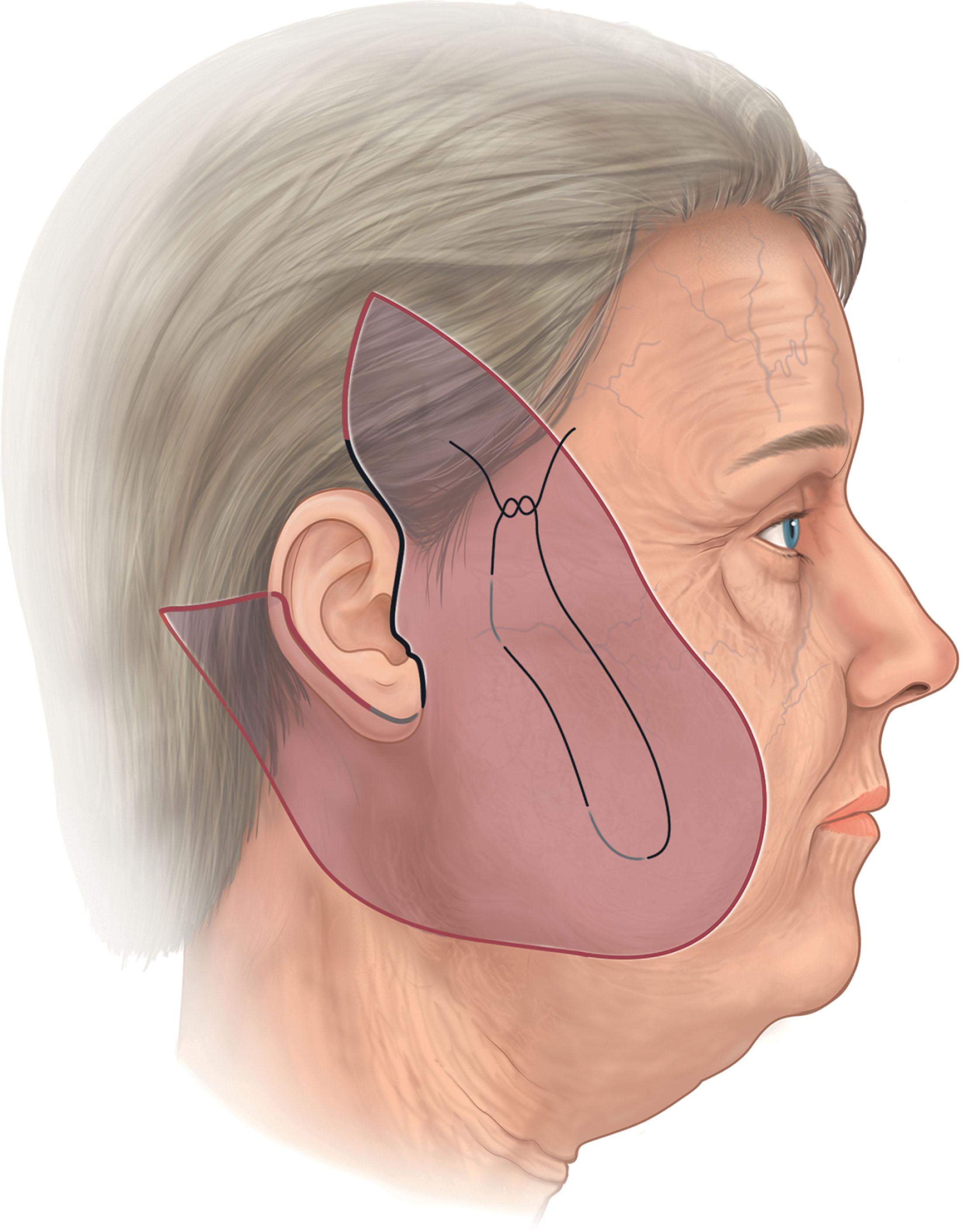Physical Address
304 North Cardinal St.
Dorchester Center, MA 02124
Predominantly oblique, but allows multivector traction to individualize the facelift.
Sutures placed closer to the point of lift have the best effect.
Delivers a good malar auto-augmentation.
Offers reduced downtime.
Safe and ideal for thin, attenuated SMAS layers or repeat facelifts.
Access video content and video lecture content for this chapter online at Elsevier eBooks+ ![]()
![]()
As summarized in Chapter 9.3 , facelifting has made great developmental strides from the skin-only procedures of the early twentieth century. Today, surgeons are faced with an almost bewildering array of techniques and tissue planes from which to choose. Whilst each technique will be strongly supported by its proponent, most will be based on the superficial musculo-aponeurotic system (SMAS), originally highlighted by Skoog in the 1970s and detailed in Mitz and Peyronie's now classic treatise. The question remains precisely what to do with the SMAS in order to balance invasiveness, and thus tissue trauma from which the patient must recover, with risk and longevity.
Options for SMAS manipulation include elevation and advancement, dissection at various planes, combination with mesh to augment malar projection, excision, or plication. The multiplicity of techniques bears testament to the fact that the universal procedure continues to elude us. There is also evidence of little practical difference, in either short or long term, between techniques of varying aggressivity; therefore, procedures with lower inherent risk to important structures, such as the facial nerve, may well be safer. Limitations noted include inconsistent results, a less-than-impressive effect on the nasolabial folds and jowls, and lengthy operations with extended periods of careful surgery, particularly with anterior SMAS dissection. Furthermore, the SMAS is relatively avascular, perhaps behaving more as a graft in certain circumstances, and may be thin and attenuated, thus providing poor anchorage for sutures. In revision or secondary surgery, the poverty of vascular supply to the undermined SMAS may present the surgeon with little more than a mass of scar tissue.
Given the inexorable drive towards minimally invasive techniques, primarily to reduce recovery time but also to limit facial nerve complications, the minimal access cranial suspension (MACS) lift was initially enthusiastically promoted. It has proven effective in younger patients with early jowling, minimal neck ptosis, and the desire for rapid recovery. Itself a derivation of Saylan's “S-lift”, the MACS lift has, however, shown certain limitations with time and experience. First, the relative lack of malar augmentation, was addressed by the addition of a third suture and quickly became routine. Precise purse-string suture placement, however, can be challenging, and subcutaneous irregularities may not always settle as well as described. The authors feel it does not always have a sufficiently potent effect on the lateral neck of older patients and is rather painful initially, with the added limitation of constrained mouth opening. Finally, there are two areas of tissue excess, or dog-ears, in pure vertical-vector lifts, which may fail to settle satisfactorily. The first lies inferior to the lobule. Second, cutaneous bunching at the lateral canthus is particularly pronounced with the powerful suture of the extended MACS and frequently needs a lower lid blepharoplasty incision; however, not all patients wish for either this additional procedure or its attendant scar. Moreover, restricting tension to the SMAS rather than the skin, both cutaneous dog-ears and scar stretch are minimized.
Experience with these limitations led the authors to the use of sutures to plicate the SMAS, a procedure termed the “platysma-SMAS plication” (PSP) lift. Its advantages ( Table 9.5.1 ) include an oblique posterosuperior, as opposed to purely vertical, vector, which allows a lift tailored to each individual. The vertically extended skin incision permits synchronous temporal lift and reduces sideburn elevation and a visible scar. Concealing the scar within temporal hair allows greater flexibility with no risk of highly visible alopecia between the helical root and hairline. A postauricular extension, not required in all cases, may be employed to ameliorate the postauricular skin dog-ear, which adds to downtime and has been similarly reported with the MACS. Actually, many patients do not appreciate that scar length is not based on surgical whim, rather the quantity of excess skin after tightening.
| Feature | PSP | MACS |
|---|---|---|
| Incision | Vertical temporal (± postauricular extension) | Inverted L (anterior only) |
| Skin flap | As required | Limited to 5 cm oval |
| Dissection into neck | Yes | No |
| Platysmaplasty | Direct (infralobular excision) | Indirect |
| SMAS fixation | SMAS–SMAS | SMAS–deep temporal fascia |
| Malar augmentation | Yes | No |
| Vector | Cephaloposterior | Predominantly vertical |
| Skin excision | Tailored, no tension | Tailored, high tension |
| Neck | Multiple procedures | Liposuction in >95% |
| Ancillary procedures | Yes | No |
With no sub-SMAS dissection, the PSP lift is safer, particularly with respect to the facial nerve, and quicker. It is also beneficial with poorly vascularized SMAS. Large bites of SMAS allow greater security and, therefore, potential longevity. A second layer of finer imbrication sutures produces both a smooth finish and perhaps additional strength. The PSP lift does produce two dog-ears in the subcutaneous layer. Fortunately, the first, overlying the malar prominence, has the effect of auto-augmentation and assists with the overall rejuvenation by square-to-triangular facial shape reversion. The second, in the infralobular region, is less beneficial but is easily excised; a maneuver common to both Baker's and Waterhouse's modified SMASectomy procedures.
The surgical procedure is as follows. Patients are prepared as for a standard facelift with tumescent subcutaneous infiltration (20 mL 0.5% bupivacaine and 1 mL 1 : 1000 adrenaline in 200 mL normal saline). The standard retrotragal incision extends vertically in the temporal scalp and on occasion into the postauricular sulcus as required ( Fig. 9.5.1 ). A postauricular extension is used where required and subcutaneous dissection tailored to each patient. The anterior SMAS is grasped in a posterosuperior direction to provide a satisfactory effect on the jowl ( Fig. 9.5.2 ). The key suture, using 2-0 polydioxanone (PDS) (Johnson & Johnson Medical Ltd, Wokingham, UK), is then inserted to attach this SMAS to the relatively immobile preauricular parotid-masseteric fascia. Similar platysma-mastoid sutures ( Fig. 9.5.3 ) serve to tighten cervical platysma, enhance mandibular angle definition, and help prevent pixie ear deformity. Any surface irregularities are addressed by suture imbrication with 3-0 Vicryl (Johnson & Johnson). Excess SMAS in the infralobular region is excised, following hydrodissection, and closed with 2-0 PDS. Following meticulous hemostasis, excess skin is trimmed and closed without tension over a small suction drain with 4-0 and 6-0 nylon. A light, compressive facelift dressing remains overnight and is removed with the drain the following morning. These can be similarly removed immediately prior to discharge in day-case patients. Sutures are removed at 4–6 days.



Become a Clinical Tree membership for Full access and enjoy Unlimited articles
If you are a member. Log in here